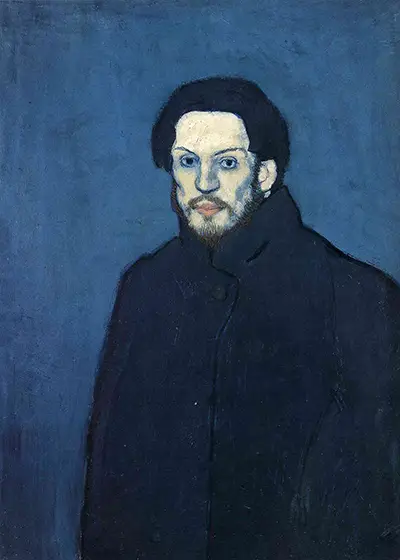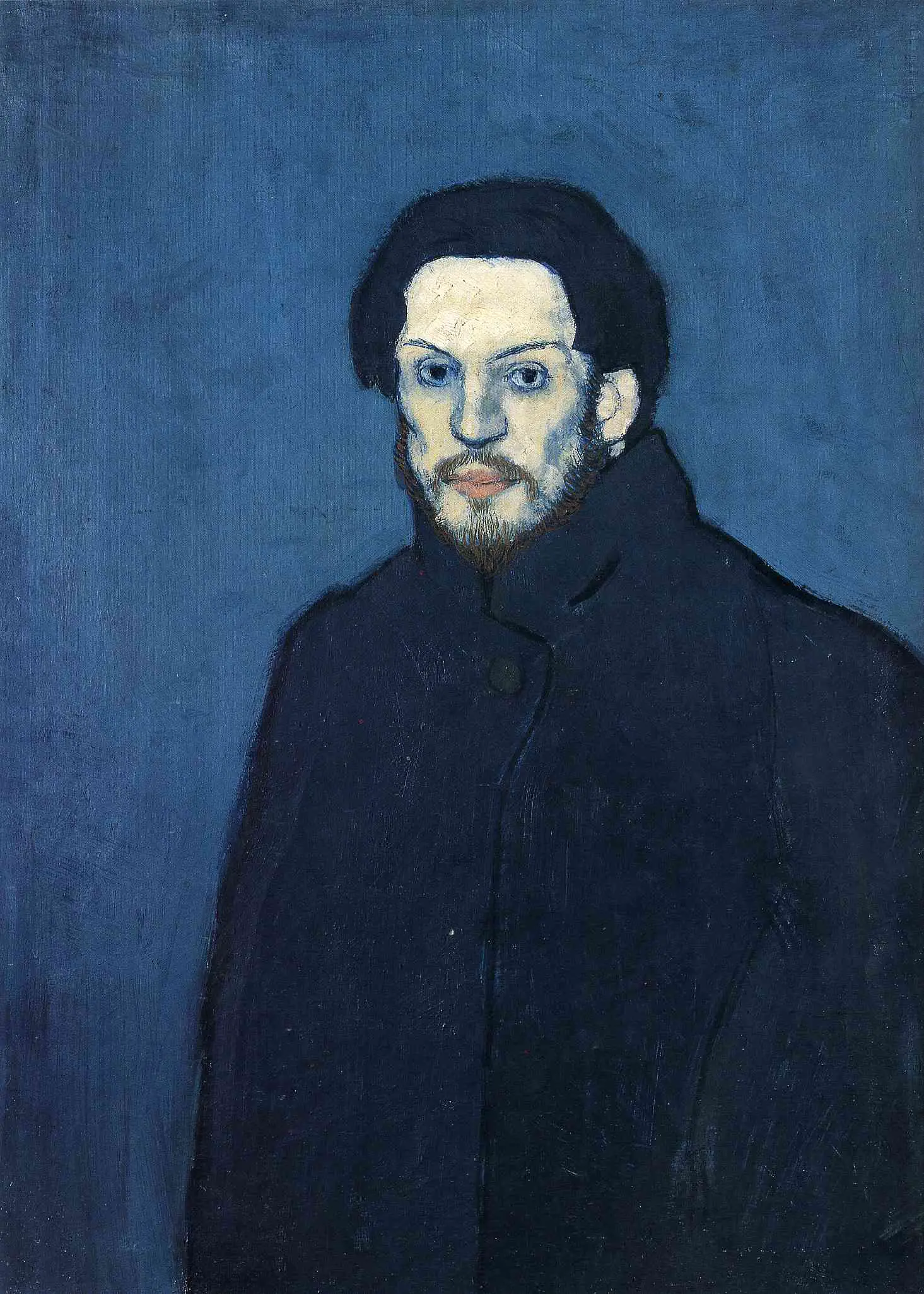Coming several months after the suicide of Carlos Casagemas, Self-Portrait 1901 gives a remarkable insight into the deep depression that the young artist suffered from following his friend's death, and is reminiscent of self-portraits by another great yet troubled artist, Vincent van Gog. Casagemas took his own life in a Parisian cafe in February, 1901, while Picasso was in travelling in Spain, and the loss had an enormous impact on the artist, who said that he started painting in blue after Casagemas' death. In Self-Portrait 1901, painted less than a year after the tragic events that had such an impact on the young, impressionable Picasso, he allows the world to see his own pain, and loneliness as he attempts to come to terms with his bereavement. The lightly brushed blue background and purple coat shows both the physical chill of the harsh Parisian winter and the emotional detachment from his surroundings. His high-collared coat is painted using nothing more than wide strokes of purple with black outlines to depict the arms and fastenings of his outerwear.
It is almost lazily painted, with areas of the background colour showing through where he used as little paint as necessary, as though he had deemed this part of himself unimportant, and certainly not worth painting with any level of detail. The background is painted in a similar manner, with tones of the base colour showing through towards the edges of the painting, giving the impression that the background, like the coat, is of little importance, and is simply a frame to his sorrow. The blue of the background could be signifying night as easily as it shows his mood, creating the idea that the young Picasso is unable to sleep due to his despair, and is, instead, wandering the frosty streets of Paris at midnight. All expressive artists have tackled their negative emotions just as much as their positive ones.
In contrast to the almost lazily-rendered background, the face of the artist, which is the focal point of the piece, is highly detailed, and shows a gaunt, pale, and unkempt, man who appears much older than his twenty years. The paleness of his completion stands out against the bleak and simple blue tones of the background and clothing, as if Picasso needed his audience to see his pain without any distraction. His cheekbones and eye-sockets are sunken, causing the young man to look almost corpse-like, with the blue of the shadows accentuating his emaciated appearance while his eyes stare straight at the observer with an emotional intensity that demonstrates his anguish in an almost pleading manner. Self-Portrait 1901 is an insight into the soul of a young and pained Picasso. It is raw in a way that only the work of an artist in the clutches of true emotional turmoil can be, though it and the rest of his Blue Period collection was not received well by the art community of the day, who preferred his earlier, less intense work.
However, the beauty in this painting does not lie in the execution of the content, but rather in the honesty of it. It does not try to belie the pain and suffering that the young artist is attempting to cope with, nor does it try to make light of the situation Picasso has found himself in; cold, hurt, and alone in a bleak Parisian winter. Instead, it remains true to the man, and the sadness and solitude that is in his heart is put on canvas for the world to see. He would use these same emotions to create some other iconic paintings within his career, including Guernica which draw on the horrors of war, as well as Weeping Woman, which focuses on the tragedy of the loss of one's child. The artist was very much a part of this movement towards greater expression and emotion within art, something that perhaps had started with the French Impressionists in the mid-19th century before developing ever onwards with the likes of Munch, Kirchner and many more. This approach retains a great popularity in the present day, where some of the more occasional art fans consider traditional art to be stale in comparison.
This painting can be found at the Musée National Picasso in Paris. Whilst being Spanish, it would be France in which he produced much of his best work and so it is entirely appropriate that many of his best work remains here. Whilst many of his highest profile works are spread around many of the world's major art galleries and museums, it is pleasing to find a good number of artworks gathered together under one roof, particularly with it being in such a prestigious location. Olga in an Armchair and Massacre in Korea are two of the items that you would certainly recognise, though their overall collection features upwards of 5,000 different artworks as well as a wide selection of other documentation from his life, such as newspaper cuttings, letters and more. For biographers, this proves highly useful, and most of it was actually donated by the artist's family upon his passing. It is perhaps a little similar to the Musee Rodin in that regard, forming a great starting point for those looking to study the artist in great depth.
Picasso was a handsome man with a charismatic personality which suited his own artistic style. He would complete large numbers of self portraits across his career, which visually document his life. As his style altered over time, so would his self portraits vary. There are many other variants included within this website as well as portraits of others too. His expression within this 1901 portrait is fairly serious, looking directly at the viewer in an honest way which helps us connect directly to him. This abundance of blue tones formed a consistent body of work over a period of several years before he moved on again to work in other ways. Most think of his single line drawings or his cubist scenes when considering this artist, but his Blue Period was also a highly important stage in his development. Expressionist artists would often look inwards for inspiration and so self portraits would often be a natural result of that. Picasso was someone who drew on these ideas but who also wanted to work in many other ways as well, helping to widen his oeuvre as much as he possibly could whilst still retaining a high level of achievement throughout.



